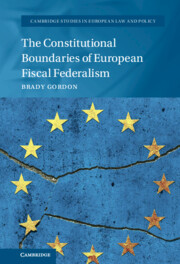Book contents
- The Constitutional Boundaries of European Fiscal Federalism
- Cambridge Studies in European Law and Policy
- The Constitutional Boundaries of European Fiscal Federalism
- Copyright page
- Basic Table of Contents
- Detailed Table of Contents
- Figures
- Acknowledgements
- Table of Cases
- Table of Legislation, Treaties and Conventions
- Abbreviations
- Part I
- Part II
- 5 The Emergent Centralized Architecture of European Fiscal Federalism
- 6 The Constitutional Boundaries of Economic and Monetary Union under EU Law
- 7 The Constitutional Boundaries of Member State Fiscal Sovereignty
- 8 Principles of Fiscal Federalism for the European Union
- Conclusion
- Proposed Directions for Future Research and Reform
- Bibliography
- Index
6 - The Constitutional Boundaries of Economic and Monetary Union under EU Law
from Part II
Published online by Cambridge University Press: 07 April 2022
- The Constitutional Boundaries of European Fiscal Federalism
- Cambridge Studies in European Law and Policy
- The Constitutional Boundaries of European Fiscal Federalism
- Copyright page
- Basic Table of Contents
- Detailed Table of Contents
- Figures
- Acknowledgements
- Table of Cases
- Table of Legislation, Treaties and Conventions
- Abbreviations
- Part I
- Part II
- 5 The Emergent Centralized Architecture of European Fiscal Federalism
- 6 The Constitutional Boundaries of Economic and Monetary Union under EU Law
- 7 The Constitutional Boundaries of Member State Fiscal Sovereignty
- 8 Principles of Fiscal Federalism for the European Union
- Conclusion
- Proposed Directions for Future Research and Reform
- Bibliography
- Index
Summary
Chapter 6 examines whether the instruments of conditional financial assistance enacted since the crisis are genuinely reconcilable with the boundaries of EMU inscribed in the Treaties as a matter of EU law. This is necessary because the text of the Treaty is but the litmus paper for determining whether a legal instrument coheres with much deeper constitutional boundaries underlying the EU legal order. It concludes, unavoidably, that conditional financial assistance under Article 136(3) TFEU and the ESM is simply not reconcilable with the legal architecture in the treaties under the analytical framework developed by the ECJ. This emerges from an analysis of the allocation of competences (within which it does not together sit) and the substantive provisions of Articles 121-126 TFEU (to which it does not adhere). This provides the first testable indication that the emerging new model is incompatible with much deeper the boundaries underlying the EU legal order.
Keywords
- Type
- Chapter
- Information
- The Constitutional Boundaries of European Fiscal Federalism , pp. 216 - 260Publisher: Cambridge University PressPrint publication year: 2022

